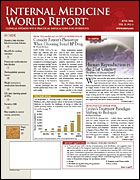Publication
Article
Internal Medicine World Report
Reducing Fracture Risk in Patients with Low BMD
Author(s):
From the American Association of Clinical Endocrinologists
CHICAGO?Despite widespread interest among patients and physicians in reducing fractures in women with low bone mineral density (BMD), there is confusion about the best treatments. Hoping to set the record straight, Nelson Watts, MD, of the University of Cincinnati, summarized the latest research at the annual meeting of the American Association of Clinical Endocrinologists.
Primary care physicians must first know how much calcium and vitamin D their patients should be taking. Calcium supplements may be a little too popular, according to Dr Watts. "I see some patients who are taking too much calcium," even >3000 mg/day, which is not helpful. "There is virtually no benefit in taking more than 1500 mg/day."
In contrast, most patients are probably not getting enough vitamin D. Dr Watts mentioned that studies have shown that vitamin D supplements reduce the risk of fractures and possibly mortality as well. One meta-analysis revealed that supplementation also helps prevent falls. He encourages physicians to obtain serum 25-hydroxyvitamin D determinations. "I measure this in virtually all my patients," he said. He pointed out that 1000 to 2000 IU/day of vitamin D is usually required to achieve an adequate serum 25-hydroxyvitamin D level of at least 30 mg/dL.
Although antiresorptive drugs are widely used, they have been shown to reduce risk of fracture only in patients with low BMD. They are not appropriate for patients at high risk of fracture for other reasons, Dr Watts said, and should be reserved for patients with osteoporosis (defined as a T score of ?2.5 or below) or with borderline-low BMD (T score ?1.5 to ?2.5) and a high absolute fracture risk.
Addressing concerns about long-term bisphosphonate use, Dr Watts said that problems are unlikely. Although there have been a few reports of osteonecrosis of the jaw and rare reports of oversuppression of bone turnover, this drug class seems to be safe for at least 5 to 10 years. After 3 to 5 years, patients who have had no fractures and are not using steroids can take a 1- to 2-year "drug holiday" from bisphosphonates.
Anabolic drugs have also been used to treat low BMD. There is some interest in combining 2 antiresorptive drugs or using an antiresorptive drug and an anabolic drug, but Dr Watts advises against multiple-drug therapy. Despite data showing a slight improvement in BMD, "there is no evidence that combining 2 drugs decreases the fracture risk," he said, adding that using 2 drugs increases both the cost and potential for side effects. Patients who do not respond to an antiresorptive drug may be switched to an anabolic drug, but physicians should always try the antiresorptive drug first, Dr Watts advises.
New bisphosphonates and anabolic drugs are likely to become available in the future. In the meantime, physicians can help reduce the incidence of fracture by educating patients about the correct dosages of calcium and vitamin D and prescribing pharmacotherapy when appropriate.
KEY POINTS
Ask all patients about their calcium and vitamin D intake.
Calcium should not exceed 1500 mg/day.
Most patients are not getting enough vitamin D, which can prevent fractures. Measure serum 25-hydroxyvitamin D levels in all patients.
Bisphosphonates are safe long-term; a "drug holiday" every 3-5 years is an option.
Reserve antiresorptive drugs for those patients who have osteoporosis or low BMD.





